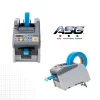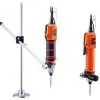
The importance of error-proofing assembly processes can’t be over emphasized. Quality control regulations for automated procedures call for a very small margin of error, so as to most effectively optimize repeatable procedures to get the best and most consistent results.
The possibility of an assembly mistake leaving the work area is not usually a risk worth taking, as it could result in expensive rework or may even put a customer contract in jeopardy. When it comes to installing threaded fasteners into an assembly there are three main error-proofing choices commonly used, and all of them can be interfaced with line controls. They are:
- Monitoring the clutch shut-off signal of an assembly tool. This approach uses an electric auto shut-off tool with a power supply that provides a clutch signal output, and verifies that the assembly tool reached torque. While this is the least expensive option, it is also the least thorough. One significant downside to this approach is that it does not catch cross-threaded fasteners or missed fasteners.
- Using a process verifier with pneumatic or electric auto shut-off screwdrivers or nutrunners. These process verifiers utilize time monitoring, clutch shut-off, and fastener counts to provide very good error-proofing functions. This method is more expensive than manual monitoring, but provides a very good method of error-proofing.
Closed-loop controlled screwdrivers or nutrunners. These systems utilize a combination of torque transducer and angle encoding feedback to both regulate and report the process. This is the best error-proofing method, but comes with the largest price tag. - The choice, as many in manufacturing or automation are familiar with, is one of determining where your project or process falls on the continuum between budget allocation and quality control. With larger budgets or larger businesses and projects, the clear benefits of stringent management and preemptive attention to potential error will justify the capital costs of automated control. With shorter term or smaller quantity jobs, it becomes a question of where best to allocate resources to organize your process as efficiently as possible.
Wherever you fall on that spectrum, ASG is glad to be able to outline the available options to help you determine what is best suited for your needs. Contact our experts today to jump start the conversation about how ASG can help you error-proof your processes. (Contributions by Phil Klingler, ASG Product Manager)







